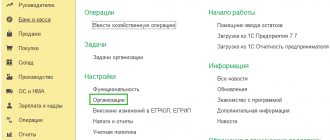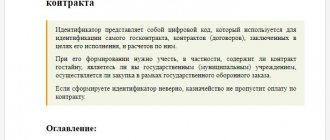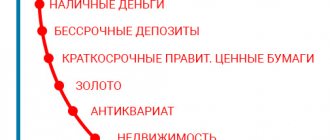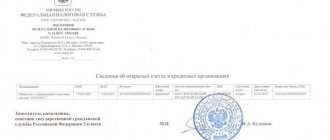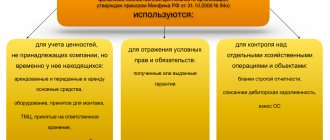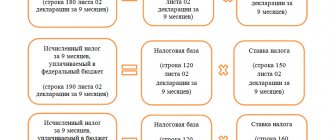Round up VAT in tax returns and payment orders for tax payments to the budget
Value added tax is reflected in many tax and accounting documents: tax returns, invoices, invoices, invoices. For this purpose, special lines are provided: “Amount without VAT”, “Including VAT”, “Amount with VAT”. The correct filling out determines what amounts the buyer will pay to the organization, and what part of it the state will take from it.
The question about tax rounding is answered by clause 6 of Art. 52 of the Tax Code of the Russian Federation: “The amount of tax is calculated in full rubles. A tax amount of less than 50 kopecks is discarded, and a tax amount of 50 kopecks or more is rounded up to the full ruble.” Similar requirements are specified in the order of the Federal Tax Service of Russia dated October 29, 2014 N ММВ-7-3/ [email protected]
Does this mean that VAT is always rounded? Unfortunately no. And this legislation misleads many novice specialists. The Tax Code deals with the procedure for calculating taxes that are payable to the budget for the period and are reflected in tax returns.
Therefore, it is possible and necessary to round up VAT in declarations, as well as in payment orders. For accounting documents that reflect the interaction of sellers and buyers, the rules are different.
Declarations and payment orders
In tax returns and payments, amounts are indicated in whole rubles.
Paragraph 6 of Article 52 of the Tax Code establishes the main rule for calculating taxes: their amount must be reflected in full rubles. The Ministry of Finance in letter dated March 5, 2014 No. 03-07-15/9519 explained that this article of the code regulates the procedure for calculating the amounts of taxes payable to the budget, which are reflected in declarations.
Rounding to whole rubles is not allowed in invoices. The legislation obliges companies to fill out these documents in rubles and kopecks.
The amount is calculated in full rubles: what is less than 50 kopecks is discarded, what is more is rounded up, says the well-known rule, which is enshrined in Article 52 of the Tax Code. However, there are exceptions to this rule that should not be forgotten. In the form of any declaration, you can see that not only the final data is rounded, but also the intermediate figures on each sheet. Therefore, if the amount of tax that the accountant reflects in the declaration, he also indicates in the payment order, there will be no discrepancies.
Do not round up VAT on invoices, purchase and sales books and source documents
This issue is also regulated by the Tax Code and letters from the Ministry of Finance.
When selling products or transferring property rights, the taxpayer must present VAT to the buyer for payment in addition to the price of the goods. In this case, the amount of VAT is calculated for each type of goods as a percentage of the price corresponding to the tax rate. For example, on a product worth 100,000 rubles, VAT at the standard rate will be 20,000 rubles on top (100,000 × 20%), and the total invoice amount will be 120,000 rubles.
The calculated amount is indicated in the invoice, and its completion is regulated not by the Tax Code, but by a special procedure developed by the Government of the Russian Federation. These rules state that the cost indicators of the document, including the column “Amount of tax presented to the buyer,” are indicated in rubles and kopecks. Similarly for other currencies - dollars and cents, euros and eurocents, etc.
Keep records of exports and imports in the Kontur.Accounting web service. Simple accounting, payroll and reporting in one service. Get free access for 14 days
Therefore, for VAT, which is indicated in the invoice presented by sellers to buyers, the rule of paragraph 6 of Art. 52 of the Tax Code of the Russian Federation.
In the books of purchases and sales, cost indicators should also be indicated in kopecks. Therefore, the tax is reflected exactly as indicated on the invoice.
In the primary case, rounding of indicators is allowed: “penny” differences in this case are written off to the financial result. But it is safer to reflect in the primary account the same amounts as in the invoices. Non-compliance may be grounds for denial of deduction.
The procedure for applying the new norm
The financial department provided the corresponding clarifications in letters dated April 1, 2014 No. 03-07-RZ/14417, dated March 5, 2014 No. 03-07-15/9519 (reported by the Federal Tax Service of Russia to lower-level structures for use in work by letter dated 7 April 2014 No. GD-4-3/ [email protected] ), dated February 17, 2014 No. 03-07-09/6395, dated January 29, 2014 No. 03-02-07/1/3444.
These letters stated that the rounding rule established by Article 52 of the Tax Code of the Russian Federation does not apply to VAT amounts charged by sellers to buyers of goods (works, services) and indicated in invoices and the sales book. In this case, officials proceed from the following standards. Paragraph 2 of Article 168 of the Tax Code of the Russian Federation provides that the amount of value added tax presented by the taxpayer to the buyer of goods (work, services), property rights, is calculated for each type of these goods (work, services), rights as a percentage of prices corresponding to the tax rate ( tariffs) of goods (works, services) sold, rights.
The invoice issued for the sale of goods (work, services), property rights must indicate the amount of tax charged to the buyer of goods (work, services), property rights, determined based on the applicable tax rates (subclause 11, clause 5 Article 169 of the Tax Code of the Russian Federation).
The procedure for filling out an invoice, in accordance with paragraph 8 of Article 169 of the Tax Code of the Russian Federation, is established by the Government of the Russian Federation.
Paragraph 3 of the Rules for filling out an invoice... states that the cost indicators in the invoice (including in column 8 “Amount of tax presented to the buyer”) are indicated in rubles and kopecks. In the sales book too (clause 9 of the Rules for maintaining the sales book).
As for paragraph 6 of Article 52 of the Tax Code of the Russian Federation, in relation to VAT, the norm established therein regulates the procedure for calculating the amount of tax payable to the budget for the tax period, which is reflected in the declaration.
Thus, the tax amount is calculated in full rubles based on the results of the tax period, and not in each primary document. That is, in full rubles, VAT amounts are indicated in the value added tax return (this also follows from clause 17 of the Procedure for filling out a tax return for value added tax, approved by order of the Ministry of Finance of Russia dated October 15, 2009 No. 104n) and, accordingly, in payment instructions when paying taxes to the budget.
The procedure for rounding VAT in invoices
You cannot round the tax, but you cannot do without it if there are more than two digits after the decimal point.
The general rule is to round taxes to two decimal places. If discrepancies arise because of this, they are not considered errors even by the tax authorities and do not require correction. But more accurate calculations indicating three or four decimal places are also not prohibited by law. Therefore, this procedure is not a violation if it helps to indicate the exact amounts.
At the same time, due to rounding, the buyer may have difficulty reflecting data in the accounting program. To prevent this from happening, some companies round all indicators up to four digits. This can also be done, but it is not necessary.
Problems with buyers
The buyer may question the accuracy of the rounded amounts. Even minor discrepancies cause constant requests from counterparties to correct documents. In this case, we suggest adding the following provision to the accounting policy: “Employees prepare primary documents and invoices in a special program. The cost of goods is automatically rounded to two decimal places. When calculating, the program takes into account VAT without rounding, so discrepancies between manual calculation and program data are possible - up to 5 kopecks.”
This provision will help solve the problem of constant customer dissatisfaction.
Problems with the tax authorities
In invoices, all costs must be indicated in rubles and kopecks. But some suppliers, due to errors or inexperience, round up the total, thereby inflating the VAT amount.
As a result, the buyer's tax deduction is overestimated. The difference will be in kopecks, but because of this, inspectors may refuse not only the difference, but even a VAT deduction in general. Therefore, resolve these issues with your counterparties in advance, and if documents are completed incorrectly, demand corrections.
Example. The company shipped 60 boxes of pineapples. Price for 1 box—RUB 1,527.36. Correct calculation. Indicate on the invoice:
If the supplier rounds the amount including VAT to 109,970 rubles, then the VAT will be overestimated, and the buyer may lose the deduction.
There are many problems and questions with VAT calculation, but the Kontur.Accounting web service will help you cope with most of them. The system automatically rounds up VAT in the manner prescribed by law. And tax returns can be submitted online. All new users receive 14 days of using the service as a gift.
On the website https://www.buhotvet.ru in the section “Presenting VAT amounts for payment to the buyer, invoices” - I found a lot of interesting and useful information about invoices, I learned a lot of useful information, but I did not find an answer to my question — (I read up to the 30th page!!! and didn’t find it) In general, on the internet I came across 3 ways to solve this problem: 1) THE MOST IDEAL AND MOST UNREALISTIC: bring all prices at the enterprise to such a form that VAT is calculated penny per penny, without tenths of a kopeck, whereas no matter how you count the VAT - forward or backward, from right to left or from left to right - everything will always add up!!! But this is unrealistic. 2) “cheat” with the invoice and manually adjust the VAT amount in some cell of the invoice - then the total amount in the VAT column will converge with the back-calculated VAT amount. But it seems to me that this is also not correct, because... again, the check may find fault that VAT was calculated incorrectly in this cell, and recognize the registration of this account as INCORRECT. 3) some enterprises went this way - they tweaked the program and used 3 decimal places in the VAT column - which also raises doubts, because You can’t fit 3 decimal places into an accounting entry; according to the law, we record in rubles and kopecks, and not in fractions of kopecks. I scoured the Internet and already came across my same question 20 times, formulated by other people, but, unfortunately, in the answers to these questions no one referred to an official explanation or at least an article in some accounting journal. It seems that everyone is trying to get out of this situation as best they can. Most probably CUSTOMIZE the invoice. Well, then, there is NO legal way out of this situation?
How to calculate VAT on top
It is much easier to charge VAT on top of a given amount. To do this, simply multiply this amount by the tax rate.
Our online calculator will not only calculate the tax, it will also show the amount excluding VAT and the total amount.
To find out the amount including VAT in one step, the accountant must multiply the amount without VAT by 1.2 (at a rate of 20%) or by 1.1 (at a rate of 10%).
Example of calculating the total amount . Let’s say a product without VAT costs 56,000 (Fifty-six thousand rubles). VAT is 10% of this amount. You need to know the total cost of the product including VAT.
Cost of goods = 56,000 × 1.1 = 61,600 rubles.
To find out the VAT amount, you need to multiply the original amount by 0.1.
56,000 × 0.1 = 5,600 rubles.
The same result can be obtained if the initial amount is multiplied by 10% (56,000 × 10% = 5,600).
To save time when calculating tax and avoid making mistakes, use an online VAT calculator.
Calculation example . Globus LLC repaired the warehouse of Mechta LLC. According to the estimate, the cost of the work excluding VAT was 83,200 (Eighty-three thousand two hundred rubles). VAT is 20%. The accountant of Globus LLC must calculate the tax and the total cost of the work.
Option #1
First we will charge VAT.
83,200 × 20% = 16,640 rubles.
Now let’s calculate the total cost of the work by adding the two amounts.
83,200 + 16,640 = 99,840 rubles.
When can VAT be rounded?
As a general rule, VAT calculated for the quarter must be paid to the budget monthly in three equal installments for three months following the reporting quarter (Article 163, paragraph 1 of Article 174 of the Tax Code of the Russian Federation).
If it is impossible to divide the amount of VAT payable without a balance, then you can round the first and second monthly payments down to full rubles, and the last one – up.
See example of rounding Based on the results of the first quarter, the total amount of VAT payable was RUB 255,892. Dividing it into three parts, you will receive 85,297.33333 rubles. In this case, in April and May you must pay 85,297 rubles to the budget, and in June – 85,298 rubles.
In which documents can you round and in which not?
In 2022, reflect the amount of VAT in invoices, purchase and sales books in rubles and kopecks.
But don’t get confused with the new VAT declaration form:
- in Sect. 1 – 7 of the VAT return, indicate all cost indicators, including the amount of VAT, in full rubles.
- in Sect. 8 – 12 of the declaration, indicate the VAT amount in rubles and kopecks, since they transfer data from invoices, purchase and sales books, and a log of received and issued invoices.
If you find an error, please select a piece of text and press Ctrl+Enter.
You can only round up VAT amounts in a tax return, but when preparing invoices and sales books, the rounding rule is not applied (Letter of the Ministry of Finance dated October 15, 2019 N 02-07-10/79001).
Officials recalled the rule for rounding taxes - the tax is calculated in full rubles. In this case, the amount is less than 50 kopecks. is discarded, and 50 kopecks. and more is rounded to the full ruble (clause 6 of Article 52 of the Tax Code of the Russian Federation).
This is the general rule for calculating taxes payable to the budget for the tax period, reflected in the declarations. It fully applies when filling out a VAT return.
As for the reflection of VAT in invoices and the sales book, there is no rounding rule in the order of filling them out (clause 3 of the Rules for filling out an invoice and clause 9 of the Rules for maintaining a sales book, approved by Decree of the Government of the Russian Federation of December 26, 2011 N 1137):
- in the invoice - cost indicators, including column 8 “Amount of tax presented to the buyer”, are indicated in rubles and kopecks (US dollars and cents, euros and euro cents or in another currency);
- in the sales book - cost indicators are entered in rubles and kopecks.
The Ministry of Finance emphasized that the difference between the amount of VAT calculated in full rubles (reflected in the declaration) and the amount of tax indicated for the corresponding period in the sales book (on the basis of which the tax return is drawn up) is not recognized as arrears.
See also:
- Incorrect invoice amount for partial deduction
- How to fill out a sales book when restoring VAT if the invoice storage period has expired
- Document Invoice received
Did the article help?
Get another secret bonus and full access to the BukhExpert8 help system for 14 days free of charge
"Simplified" tax
In 2012, the Supreme Arbitration Court of the Russian Federation, by its decision No. 8116/12, recognized clause 2.11 of the Procedure for filling out a tax return paid in connection with the use of the simplified tax system as not corresponding to the Tax Code. This norm stipulates that all values of cost indicators when filling out a declaration for a “simplified” tax are indicated in full rubles. The Supreme Arbitration Court concluded that this rule leads to a change in the tax liability of entrepreneurs. Therefore, these amounts do not need to be rounded.
A confusing situation arises with the “simplified” tax. On the one hand, there is the indicated decision of the Supreme Arbitration Court, on the other hand, there is the current version of Article 52 of the Tax Code, which clearly establishes the rule on tax rounding. But clause 2.11 of the Procedure remained ineffective. It turns out that firms are faced with a dilemma. The Ministry of Finance tried to resolve it. In Letter No. 03-11-06/2/29385 dated July 24, 2013, the department explained: in the Book of Accounting for Income and Expenses of organizations and individual entrepreneurs using the simplified tax system, all indicators should be indicated in full rubles.
However, the Ministry of Finance then made an interesting conclusion. The department admitted that in the declaration for the “simplified” tax, taking into account the position of the Supreme Arbitration Court, all values of cost indicators should be indicated in rubles and kopecks, without rounding. At the same time, officials point out: given that all indicators in the Book of Income and Expenses are filled out in full rubles, it is possible to indicate all values in a similar way in the tax return. However, in my opinion, it is dangerous to follow the position of the Ministry of Finance, because there is an unequivocal decision by YOU, and in the event of a legal dispute, it is likely that the arbitrators will apply the position of the highest court.
Marina Skoudutis
, for the magazine "Calculation"
Automatic calculations for accountants for free
Free calculators for vacation pay, VAT, personal income tax, penalties, as well as basic calculations in examples in the accountant’s handbook >>
Tax agent: pay VAT with or without kopecks
The article from the magazine “MAIN BOOK” is current as of November 10, 2017.
Contents of magazine No. 22 for 2022 TAX AGENTL.A. Elina, leading expert When an organization acts as a tax agent for VAT, it must withhold this tax from the taxpayer’s income and transfer it to the budget. Sometimes the calculated VAT amount is not in full rubles, but in rubles and kopecks. Is it necessary to round up VAT to full rubles when deducting? What about paying to the budget? It turns out that these similar questions have different answers.
The topic of the article was suggested by Deputy Chief Accountant of School World LLC Maria Demasheva, Moscow
Where do the “agency” pennies come from?
The Tax Code instructs the agent:
•calculate VAT at the established rate and draw up an invoice. 1-3 tbsp. 161 Tax Code of the Russian Federation;
•withhold this amount from the taxpayer's income;
•pay tax to the budget.
In invoices and in the sales book, the calculated tax is indicated in rubles and kopecks. 3 Rules for filling out an invoice, approved. Government Decree No. 1137 dated December 26, 2011 (hereinafter referred to as Decree No. 1137); Letter of the Ministry of Finance dated April 22, 2014 No. 03-07-07/18585.
But taxes must be paid to the budget in full rubles. 6 tbsp. 52 of the Tax Code of the Russian Federation. However, according to the explanations of the Ministry of Finance, this rule applies only to VAT amounts payable based on the results of the declaration. Letter of the Federal Tax Service dated 04/07/2014 No. GD-4-3 / [email protected] (together with the Letter of the Ministry of Finance dated 03/05/2014 No. 03-07-15 /9519).
As a result, some tax agents pay tax in full rubles, others in rubles and kopecks. And during the reconciliation, it may turn out that you and your inspection have different views on whether it is necessary to round up agency VAT when paying.
The inspectors' view of VAT payment
•in full rubles - if the tax is paid based on the results of the declaration. This is, for example, payment of agency VAT when renting state or municipal property;
•in rubles and kopecks - if the tax is paid not based on the results of the declaration, but for each transaction. For example, when paying money to a foreign contractor for services purchased from him.
But it turns out that everything is a little different.
Payment of VAT by a tax agent
| DUMINSKAYA Olga Sergeevna Advisor to the State Civil Service of the Russian Federation, 2nd class |
— When calculating the amount of VAT, the tax agent must draw up an invoice. 3 tbsp. 168, paragraphs. 5, 6 tbsp. 169 of the Tax Code of the Russian Federation.
When drawing up an invoice, cost indicators in columns 4-6, 8 and 9 must be indicated in rubles and kopecks. 3 Rules for filling out an invoice, approved. Resolution No. 1137. Such an invoice is registered in the sales book, which is also kept in rubles and kopecks - without any rounding. 9, 15 Rules for maintaining a sales book, approved. Resolution No. 1137.
Taking into account the above, the tax agent must withhold from the taxpayer’s income the amount of VAT in rubles and kopecks. But the amount of tax payable to the budget is calculated in full rubles: the tax amount is less than 50 kopecks. is discarded, and the tax amount is 50 kopecks. and more is rounded to the full ruble. 6 tbsp. 52 of the Tax Code of the Russian Federation.
Thus, the amount of VAT payable to the budget by the tax agent both during a specific tax period (for example, for the services of foreign companies) and for a specific tax period (for example, when renting state and municipal property) is reflected on line 060 Section 2 of the VAT return in full rubles. Such amounts are also transferred by the tax agent in full rubles.
As you can see, it’s all about the peculiarities of filling out the VAT return.
Tax officials transfer to personal accounts exactly the amounts of taxes indicated in the declarations. So, when paying agent VAT in full rubles, there will be no discrepancies between the data specified in the declaration and the amount received from you. That is, there will be no arrears or overpayments.
If you pay the exact amount including kopecks, the following may occur:
•or a small overpayment (from 1 to 49 kopecks);
•or a small underpayment (from 1 to 50 kopecks). In this case, you may be charged a penalty. 7 tbsp. 75 of the Tax Code of the Russian Federation. Considering that the amount of arrears is meager, the amount of penalties will also be small.
How to claim VAT for deduction
After payment, agency VAT can be deducted if the agent is himself a taxpayer, and the work or services are used in activities subject to VAT. 3 tbsp. 171 Tax Code of the Russian Federation.
How to claim an agent VAT deduction if it is calculated and, accordingly, indicated in the invoice with kopecks? But at the same time, paid to the budget in whole rubles? Here are the explanations given by a tax specialist on this matter.
Agent VAT deduction
— After paying VAT to the budget, the tax agent can register the invoice in the purchase book. In this case, VAT amounts must be indicated in rubles and kopecks. 8 Rules for maintaining a purchase book, approved. Resolution No. 1137. However, deduction is possible only for the amount of VAT that was paid to the budget. It is this amount, expressed in full rubles, that will be reflected on line 180 of section 3 of the VAT return.
For example, VAT when paying for services of a foreign organization is withheld in the amount of 5,689 rubles. 49 kopecks It is this amount that must be reflected in the invoice, which must be drawn up by the tax agent. You must pay 5,689 rubles to the budget. And this same amount must also be shown on line 060 “Tax amount” of section 2 of the VAT return.
In the sales book, the invoice is recorded in rubles and kopecks. In the purchase book, the tax agent (if the conditions for VAT deduction are met) also registers such an invoice in rubles and kopecks. That is, the tax amount will be indicated in the purchase book as 5689.49 rubles.
However, VAT deduction will be provided only for the amount paid to the budget, that is, without taking into account kopecks. Indeed, in section 3 of the VAT return, all amounts are indicated in full rubles.
If during one tax period (quarter) the tax agent withheld VAT on several transactions, due to rounding, insignificant discrepancies between the purchase book/sales book and the declaration are possible. There is no need to be afraid of this. There should be no problems with the desk verification of the declaration.
* * *
In accounting, the amount of discrepancies due to tax rounding when paying and filling out a declaration can (for example, at the end of the year) be attributed to financial results. 25 Regulations, approved. By Order of the Ministry of Finance dated July 29, 1998 No. 34n; Letter of the Federal Tax Service for Moscow dated January 28, 2005 No. 21-11/5447. That is, these amounts can be written off from account 68 (sub-account “Calculations with the budget for VAT”) either to the debit of account 91-2, or to the credit of account 91-1.

